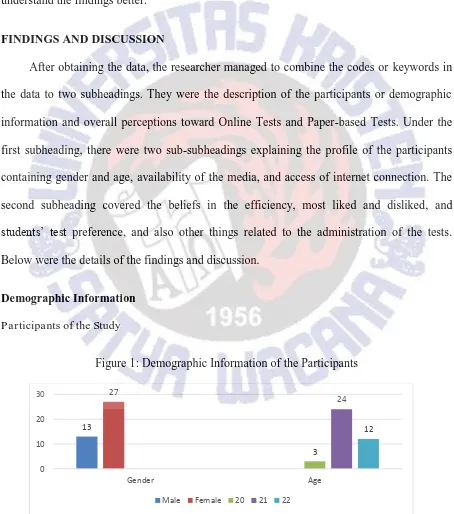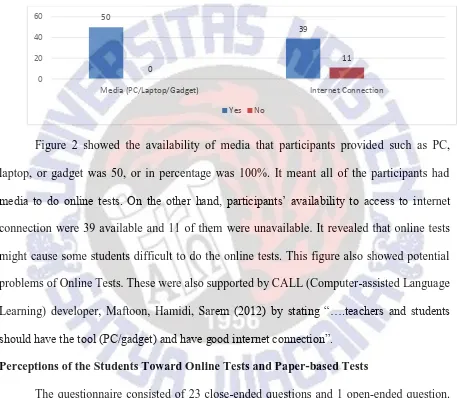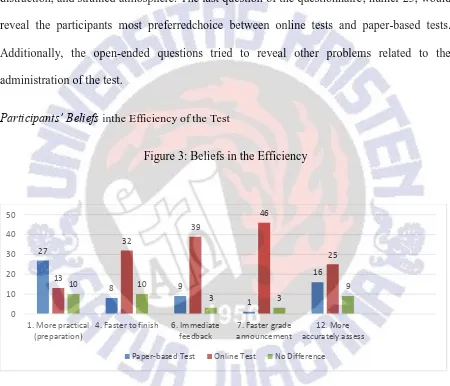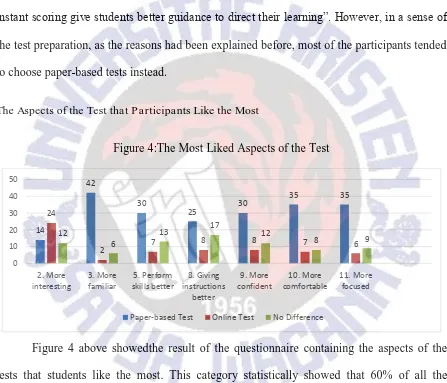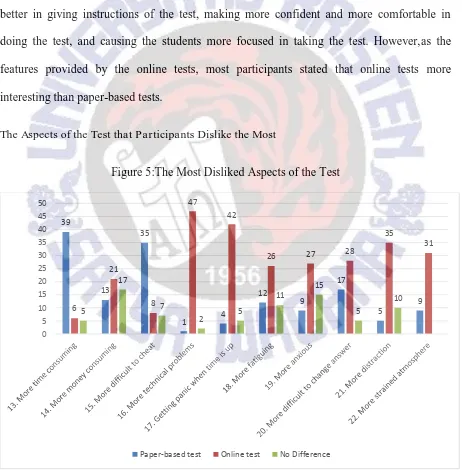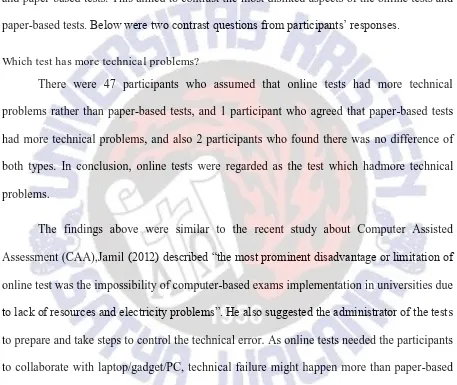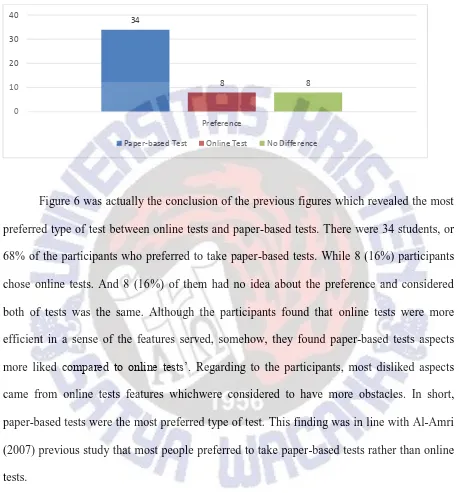STUDENTS’ PERCEPTIONS TOWARD ONLINE TESTS VS. PAPER
-BASED TESTS AT THE ENGLISH LANGUAGE EDUCATION
PROGRAM
RESEARCH REPORT
Submitted in Partial Fulfilment of the Requirements
for the Degree of Sarjana Pendidikan
Wenda Rahmadita
112013042
ENGLISH LANGUAGE EDUCATION PROGRAM
FACULTY OF LANGUAGE AND ARTS
UNIVERSITAS KRISTEN SATYA WACANA
SALATIGA
i
STUDENTS’ PERCEPTIONS TOWARD
ONLINE TESTS VS.
PAPER-BASED TESTS AT THE ENGLISH LANGUAGE EDUCATION
PROGRAM
RESEARCH REPORT
Submitted in Partial Fulfilment of the Requirements
for the Degree of Sarjana Pendidikan
Wenda Rahmadita
112013042
ENGLISH LANGUAGE EDUCATION PROGRAM
FACULTY OF LANGUAGE AND ARTS
UNIVERSITAS KRISTEN SATYA WACANA
SALATIGA
vi
COPYRIGHT STATEMENT
The thesis contains no such material as has been submitted for examination in any course or accepted for the fulfillment of any degree or diploma in any university. To the best of my knowledge and my belief, this contains no material previously published or written by any other person accept where due reference is made in the text.
Copyright@ 2017. Wenda Rahmadita and Drs. Anton Wahyana, M.A.
All rights reserved. No part of this thesis may be reproduced by any means without the permission of at least one of the copyright owners or the English Department, Faculty of Language and Arts, Universitas Kristen Satya Wacana, Salatiga.
vii
TABLE OF CONTENT
COVER PAGE
INSIDE COVER PAGE ... i
PERNYATAAN TIDAK PLAGIAT ... Error! Bookmark not defined. PERNYATAAN PERSETUJUAN AKSES ... vi
APPROVAL PAGE ... Error! Bookmark not defined. PUBLICATION AGREEMENT AND DECLARATION...v
Definition of Perception ... 3
Definiton of Test ... 4
Advantages and Disadvantages of Online Test ... 4
Advantages and Disadvantages of Paper-based Test ... 5
Relevant Studies ... 6
THE STUDY ... 7
Context of the Study ... 8
Participants ... 9
Data Collection Instruments ... 9
Data Collection Procedures ... 10
Data Analysis Procedures ... 11
FINDINGS AND DISCUSSION ... 11
Demographic Information ... 11
Figure 1: Demographic Information of the Participants ... 11
Figure 2: Participants’ Availability of Media and Internet Connection ... 12
Participants’ Beliefs in the Efficiency of the Test ... 13
Figure 3: Beliefs in the Efficiency ... 13
The Aspects of the Test that Participants Like the Most ... 15
Figure 4: The Most Liked Aspects of the Test ... 15
The Aspects of the Test that Participants Dislike the Most ... 17
Figure 5: The Most Disliked Aspects of the Test ... 17
Participants’ Test Preference... 20
viii
Other things related to the administration of the test ... 21
Figure 7: Other Things Related to the Test ... 21
CONCLUSION... 22
References ... 25
ACKNOWLEDGEMENTS ... 26
1
STUDENTS’ PERCEPTIONS TOWARD ONLINE TESTS VS. PAPER
-BASED TESTS AT THE ENGLISH LANGUAGE EDUCATION
PROGRAM
WENDA RAHMADITA
112013042
ABSTRACT
This study addressed the students’ perceptions toward online tests and paper-based tests issue experienced by students of English Language Education Program (ELEP) at the Faculty of Language and Arts (FLA) of Universitas Kristen Satya Wacana (UKSW). This study attemped to answer the research question: ‘What are students’ perceptions toward online tests and paper-based tests at ELEP of UKSW?’. The participants of this study were 50 students from batch 2013 of ELEP. They were asked to complete the questionnaire related to their perceptions toward both type of tests. Through qualitative-descriptive manner analysis, it was signified that theonline tests effeciency was higher than paper-based tests, and paper-based tests had more aspects that were liked comapred to online tests, consequently, online tests had more aspects that were disliked by the students, while students’ test preference was paper -based tests compared to online tests. The students also mentioned other things related to the administration of the tests that had not been stated in the questionnaire. This study might help the teachers who have implemented both types of tests to decide the better way of assessing students’ material mastery which was the most efficient and beneficial for both students and teachers.
Keyword: Online tests, Paper-based tests, Preference
INTRODUCTION
It is generally recognized that assessment is a way to determine the achievement of
the objectives of the educational institutions. The goals of the assesment are to measure and
evaluate students in class during a certain period of time. In the traditional formal classroom,
according to Hatfield and Gorman (2000), as cited in Demicri (2006), “assessment has been
conducted with paper and pencil using questioning techniques such as multiple choice,
constructed response, fill-in-the-blank, and essay items". However, advancements of
technology have led to new methods of students assessment. With the evolution of web-based
2
computer-based forms (Demirci, 2006). In terms of many features serve in online tests, they
are now more widely done rather than paper- based test by some schools and universities.
Although automated assesement-gradually has already replaced traditional methods of
assesment, but it is not clear yet to up to what extent these changes will be beneficial to the
academicians.
A study indicated that “students like many features of online test such as: posibility of
multiple attempts, receiving immediate feedback, working at their own pace, and having
access to the correct answers after submitting their works” (Sagarra and Zapata, 2008). On
the other hand, the researcher negatively evaluated the experience of doing online test. There
are chances that a technical failure may happen when doing the test.
However, only few studies have been carried out on students’ perceptions of online
test vs paper-based test in Indonesia, therefore I am interested in doing research at ELEP
(English Language Education Program) in FLA (Faculty of Language and Art) of UKSW
(Universitas Kristen Satya Wacana), Indonesia. The data were collected using
open-closed-ended questionnaire. This study addressed the following research question ‘What are
students’ perceptions toward online tests and paper-based tests at the English Language
Education Program of Universitas Kristen Satya Wacana?’
Since “the purpose of the implementation of the online assessment is to improve the
students’ learning, it is important to investigate the students’ perceptions toward online
assesments before reaching the Confirmation stage” (Yushau and Khan, 2014, pp. 14).
Confirmation stage is a stage where the users (students or teachers) has confirmed that
traditional tests are able to be replaced with online tests which are the more effective way to
assess and can be used continously in the future. The objectives of this report are to
3
most preferred between online tests and paper-based tests, thus, could make a more
comfortable condition and valid result of test. Hopefully, the findings of this study may be
helpful for teachers who have implemented both types of tests to decide the better way of
assessing students’ material mastery which was most efficient and beneficial for both
students and teachers.
LITERATURE REVIEW
There have been some previous studies that mainly focused on the comparability
between Online Test and Paper-Based Test result. However, the impact of the technology to
the students, as the test taker, is still less researched. Therefore, an issue of students’
perceptions toward online tests and paper-based tests has been one of the important things to
be more deeply explored.
Definition of Perception
According to Eggen and Kauchak (2001) “perception is the process by which people
attach meaning to experiences”. Wittrock (1986), as cited in Nugraeni (2013), argued that by
knowing students’ perceptions related to the learning process, it will be the reflection for both
students and teacher. Moreover, there are some factors that influence someone’s perception.
Rao and Narayana (1998) stated three internal factors that are “needs and desires, personality,
and experience”. Beside, Nugraeni (2013) also added “individual characteristic behavior can
be another factor of students’ perceptions.
From the definition above, it could be concluded that students’ perceptions are the
way they mean something to reflect their experiences in their environment and use their
behaviour as their reference. In other words, it means what students perceive or think related
4 Definiton of Test
Nugraeni (2013) stated “the assesment is used to measure the students’ understanding
toward the materials that have been taught or as an instrument to evaluate the students’
learning progress”. Assessment is a tool for teachers to evaluate students’ progress in the
learning process. What are evaluated by the tests are the students’ performance, skills, and
understanding within the material taught. In some period of time, teacher is responsible to
hold a test in order to know students’ ability in a certain lesson or course. In this context,
recently, assessment as a mean of test has two well-known types. One of the types which has
been developed by the educational administration is an online test and another one is a
paper-based test.
Advantages and Disadvantages of Online Test
“Computer-Assisted Assessment (CAA) encompasses a range of activities, including
the delivery, marking, and analysis of all or part of the students assessment process using
stand alone or networked computers and associated technologies” (Ozden, et al. 2004). This
implies that an online test is practical, less time and money consuming, accurate, and also
fast. He also added, the most prominent features of the system were “immediate feedback,
randomized question order, item analysis, and obtaining scores immediately after the exam”.
Demicri (2006) explained further about the benefits of online tests. They included “obtaining
students’ result faster, having the ability to place grades into electronic format, focusing on a
students-centered environment, and costing less compared to paper-based exams”. Another
benefit offered by the online tests is that the test can be done by a large amount of students at
the same time and the same test conditions.
However, an online test sometimes causes anxiety to the students as they are not
familiar to the web interface and system. As Al-Amri (2007) argued “some people who are
5
prefer not to takle or deal with any form of technology nor apply it in their academic or social
lives”. This might be relevant to students’ anxiety as the learners never be trained to use the
web before. One of the solutions is that the students need to know and get used to the layout
of the test with instructional practice.
In addition, an online test that is done individually at home can be regarded as
‘plagiarism and academic dihonesty’ (Rowe, 2004). It is possible for the user to do the test by
working in group and/or opening some sources via internet to find the answers. Therefore, an
online test is better done at the same time and place and be supervised by the teacher. It will
decrease the possibility of cheating among test takers.
According toJamil (2012), the most prominent disadvantage or limitation of online
test was “the impossibility of computer-based exams implementation in universities due to
lack of resources and electricity problems”. This technological problem might cause the
system of examination unreliable. He also added the solution can be to take preliminary steps
to control unexpected technological problems by the administration of the tests.
Moreover, Yushau and Khan (2014) added other limitations that online tests have are
“students must have reliable access to networked computers without time-restricsions, some
technical hitces, such as sluggish internet connection, network jam, or sudden disconnections
may render the assessment”.
Advantages and Disadvantages of Paper-based Test
A paper-based test is the assessment that is done on the piece of paper using a pen or
pencil, usually in the same place and time. Teachers also immediately supervise the run of the
test and the feedback can only be done after all of the students submit the work sheet or even
take longer after the submission. According to Burnaz (2011), “the most widely used type of
6
answers and essay”. The tools and techniques of a traditional test are considered as effective
tools in educational settings which consider memorization by repetition important. Regarding
to the academic dishonesty, a paper-based test is lower than a Computer-based test.
However, Huerta and Macias (1995) points out that students might sometimes get
anxious with the tests and it distracts their focus. Since the atmosphere of the test is
sometimes strained and the condition of every student who is doing the test is different (sick,
sad, sleepless, etc), it causes a paper-based test low in validity.
Candrlic, et al. (2014) stated, “set of questions used in paper-based tests for observed
courses had been created over a longer period of time”. It is because in paper-based tests, the
students are required to write down the answer by themselves. Apparently, it takes longer
time than the way students do the online tests (clicking the answers).
Moreover, Burnaz (2011) added that there is no feedback provided to the learner in
this type of assesment. Usually, the students just do the test in class and get the score after
being corrected by the teacher and it will usually take long time.
Relevant Studies
There have been some relevant studies about students’ perceptions toward online test
and paper-based test. The two of them were Ozden, et al (2004) and Fageeh (2015). Ozden, et
al. (2004) studied the students perceptions of online assesment in general and categorized
fields of online assessment systems. Their goals were to investigate students’ perception of
the use of CAA, to investigate the potential for using students’ feedback in the validation
assessment, and to determine the student’s perceptions of online assessment. The participants
were third-year students enrolled in the course by the Department of Computer Science at
Kocaeli University, Turkey. They completed a questionnaire and the researchers interviewed
7
system has high effectiveness for the students. The result also suggested that computer and
assessment tool familiarity (unfamiliar content and low attaining examinees), the warm
atmosphere of the test, close cooperation and technical units, are key factors that should be
paid attention to succesfully create an efficient online test.
The second study by Fageeh (2015) was about EFL students and faculty’s perceptions
of and attitudes towards the use of online assesment and practice in a Saudi University. It
specially aimed to determine self efficacy, usefulness, enjoyment, behavioural intentions, and
satisfaction of the online assesment system. The participants were a sample of 400 students of
different age categories and educational levels, and also 25 teachers of the English
department. The data instruments were collected using questionnaire. The results implied that
creating web-based assesment technology awareness, motivation, and changing faculty and
learners’ behaviours and attitude is required for the e-testing adoption, implementation, and
diffusion for the future.
There are some similarities between both studies. It was that they both concerned on
the familiarity of the system. Unfamiliar interface and procedures will cause the students
confused. Moreover, both of the them also use quantitative data collection which is
questionnaire.
Therefore, this study researched the limitation from both previous studies, which was
actually the basic for teacher to investigate students’perceptions and preference between
online tests and paper-based tests.
THE STUDY
This study addressed students’ experiences in doing online tests in some
courses at the English Language Education Program (ELEP), Faculty of Language and Arts
8
the researcher examined a research question: ‘What are students’ perceptions toward online
tests and paper-based tests at the English Language Education Program in Universitas Kristen
Satya Wacana?’
Context of the Study
This research was done at the Faculty of Language and Arts of Universitas Kristen
Satya Wacana, Salatiga, Central Java, Indonesia. The faculty has 3 majors which are English
Language Educational Program (ELEP), English Language Literature Program (ELLP), and
Arts Program. In ELEP, there are some courses that require students to do the test before
passing the course. Such as Basic Grammar (Paper-based test), Sociolinguistics (Paper-based
test), Language Assessment (Online Test), Introduction to research (Online test), Research
Method (Online Test), and many more.
There are two kinds of tests that come along with the courses which are Online test
and Paper-based test. The type of the test is decided by the lecturers who teach the course.
For the online test, the students are given a range of time from 07.00 AM-11.59 PM to
do the test. However, the time provided is only 30 hours after the link of the test is opened.
There are around 30 questions in the form of true-false, multiple choices, and/or choosing
some true statements. Nevertheless, every student has different questions that have been
randomized by the system, so they cannot cheat their friend’s work. After doing the test, the
students click ‘SUBMIT AND FINISH’ and then they can immediately see their grade and
correct answers as the feedback.
While a paper-based test requires lecturer to provide work and questions sheet. It is
done in the classroom at the same time and place, and all of the students must attend the test.
The lecturer will supervise the test from the start until the time is up. Additionally, the
9
in the test and get 0 “zero” from the lecturer. After the time is up, all students must have
submitted their work and questions sheet to the lecturer and then allowed to leave the
classroom. Unfortunately, there is no immediate feedback after the test. After all of the works
have been collected, the lecturer will do the correction and grade the test manually. The result
will usually be distributed to the students in the following week.
Participants
The participants were fifty students of ELEP that consisted of 37 females and 13
males. The amount of fifty students represented a total of 100 students from Batch 2013
chosen because they were considered enough to get data. They all had done online tests and
paper-based tests in some courses and considered to be able to give valid data based on their
experience. The sampling method used was purposive sampling because they should have a
certain criteria that they must have experienced both types of the tests more than once.
Another sampling method was convenience as the participants were selected based on the
willingness and their accessibility to complete the questionnaire.
Data Collection Instruments
Questionnaire was the only instrument that was used by the researcher. This was
chosen because it was practical and could collect a large number of data in a short period of
time and relatively cost effective way, distributing it could also limit affect to the validity and
reliability. The data that were collected could be easily analyzed with elaborated details and
accurately ensured.
The study used mixed-type questionnaire that was adapted from Saad Al-Amri
(2007), ‘Computer-based vs Paper-based Testing: Does the test administration mode
matter?’. It consisted of 23 close-ended and 1 open-ended one in order to elicit information
10
questionnaire consisted of 23 questions with 3 columns to choose among ‘Paper-based test’,
‘Online Test’, and ‘No Difference’, while the open-ended part could be freely answered on
the space provided. The first two parts of the questionnaire elicited the purpose of the study
and basic demographic information, including gender, student number, and their age. For the
basic information of their availability to take the online test, the reseracher gives 2 questions
that should be answered ‘yes’ or ‘no’. The questionnaires were then distributed to the 50
participants.
Data Collection Procedures
The reseacher was actually in the same classwith the participants. At the end of the
class the reseacher asked for their approvalto help completing the questionnaire. The
questionnaire was distributed to the participants. They were asked to give honest answers, as
the reseacher guaranteed their anonymity. The participants completed the questionnaires and
submitted at the same time. It was not only done to one class, but also to other classes that
were attended by Batch 2013 so that the reseacher could get more than 50 questionnaires and
sorted 50 completed questionnaire that could be considered as the valid data.
The researcher also piloted the questionnaire to 10 participants. They were chosen
because they represented 20% of the total participants. After making some revisions, the
questionnaire was distributed to all 50 participants excluding the pilot participants.
The closed-ended questions were tabulated by counting the number of the responses,
while the open-ended one was selected, reduced the unnecessary data, and then clasified them
into certain group. All of the data were then recapped and analyzed in qualitative-descriptive
11 Data Analysis Procedures
After getting all the data needed, the researcher carefully read and started to input the
data to Microsoft Excel. The researcher also coded and categorized the data based on some
important keywords. The data was divided into several different subheadings and
sub-subheadings. Next, the data was displayed in figures and description so that the readers would
understand the findings better.
FINDINGS AND DISCUSSION
After obtaining the data, the researcher managed to combine the codes or keywords in
the data to two subheadings. They were the description of the participants or demographic
information and overall perceptions toward Online Tests and Paper-based Tests. Under the
first subheading, there were two sub-subheadings explaining the profile of the participants
containing gender and age, availability of the media, and access of internet connection. The
second subheading covered the beliefs in the efficiency, most liked and disliked, and
students’ test preference, and also other things related to the administration of the tests.
Below were the details of the findings and discussion.
Demographic Information
Participants of the Study
Figure 1: Demographic Information of the Participants
12
In Figure 1, the participants of this study were 13 male and 27 female students. For the
age of the participants, 3 participants were 20, 24 participants were 21, and the rest 13 were
22. The average age of the participants was 21 years old.
Participants’ Availability
Figure 2: Participants’ Availability of Media and Internet Connection
Figure 2 showed the availability of media that participants provided such as PC,
laptop, or gadget was 50, or in percentage was 100%. It meant all of the participants had
media to do online tests. On the other hand, participants’ availability to access to internet
connection were 39 available and 11 of them were unavailable. It revealed that online tests
might cause some students difficult to do the online tests. This figure also showed potential
problems of Online Tests. These were also supported by CALL (Computer-assisted Language
Learning) developer, Maftoon, Hamidi, Sarem (2012) by stating “….teachers and students
should have the tool (PC/gadget) and have good internet connection”.
Perceptions of the Students Toward Online Tests and Paper-based Tests
The questionnaire consisted of 23 close-ended questions and 1 open-ended question.
The questions number 1, 4, 6, 7, and 12 of the closed-ended questionnaire were grouped into
a subheading:‘participants’ beliefs in the efficiency of the test’ which represented the tests
practicality, speed, feedback availability, instant score availability, and accuracy of online
tests and paper-based tests. Moreover, the questions number 2, 3, 5, 8, 9, 10, and 11 were also
13
most’which incuded the participants’interest, tests familiarity, participants’ skills
performance, participants’ confidence and comfort, and their focus. Other 10 questions,
number 13, 14, 15, 16, 17, 18, 19, 20, 21, and 22 were categorized into ‘the aspects of the test
that participants dislike the most, such as time consumption, money consumption, cheating
chance, technical problems, panicky, fatigue, anxiety, answers changing, environment
distraction, and strained atmosphere. The last question of the questionnaire, numer 23, would
reveal the participants most preferredchoice between online tests and paper-based tests.
Additionally, the open-ended questions tried to reveal other problems related to the
administration of the test.
Participants’ Beliefs inthe Efficiency of the Test
Figure 3: Beliefs in the Efficiency
Figure 3 above showed the result of the questionnaire containing participants’ beliefs
in the efficiency of the tests. Sixty two percent (62%)out of total participants believed that
online tests’ efficiency was higher than paper-based tests. Below were the details of the most
earned responses of the test efficiency both online tests and paper-based tests in order to
contrast both results.
Which test announces the score faster?
14
There were 46 participants who chose online tests as the tests which announce the
score faster. One of the participant chose paper-based tests, while 3 remaining participants
out of 50 decided to choose ‘no difference’. Hence, online tests were more likely to be
efficient in a way of announcing the score of the tests’ results faster.
This was in accordance toDemicri (2006) who explained further about “the benefits
of online tests which included obtaining students’ result faster, having the ability to place
grades into electronic format…”. This was also in line with Fageeh (2015) statement, “Web
-based assessment and practice provided students with automated scores that help students to
have more control over their work and their effort”. This was regarded as a beneficial feature
for both students and teacher since the score showed students’ performances. Therefore, by
knowing the score faster, they could reflect their learning process sooner.
Which test is more practical in terms of the preparation?
There were 13 participants who considered that online test was more practical, yet 27
of the participants chose paper-based test, and other 10 participants assumed that both tests
were practical.In short, the students believed that in terms of the preparation paper-based tests
were higher intheir practicality.
This was the same as Jamil (2012) statement, “online systems of examination
overburden students to prepare the exams”. To take an online test, the participants had to
bring their laptop/PC/ or gadget and also connected to the internet, while to take paper-based
tests, the participants did not have to prepare anything but writing tools (pen, pencil, and
eraser). Therefore, some participants chose paper-based because anyone could attend the test
without preparing any big tools and connecting to the internet.
This discussion might conclude that online tests were believed as the type of test with
15
they could announce the score faster rather than paper-based tests. Other features of online
tests that revealed their efficiency were faster to finish as the time provided by online test was
shorter rather than paper-based test, immediate feedback after the test done, and more
accurately assess the results of the tests. As previously Burnaz (2011) stated, “there is no
feedback provided to the learner in paper-based tests”.Fageeh (2015) also had previously
said, “web-based assessment with features of immediate feedback, clear instruction, and
instant scoring give students better guidance to direct their learning”. However, in a sense of
the test preparation, as the reasons had been explained before, most of the participants tended
to choose paper-based tests instead.
The Aspects of the Test that Participants Like the Most
Figure 4:The Most Liked Aspects of the Test
Figure 4 above showedthe result of the questionnaire containing the aspects of the
tests that students like the most. This category statistically showed that 60% of all the
participants thought that paper-based tests features were more liked rather than online tests.
The deeper explanation should meet certain criteria which was the highest percentage of both
16
Which test is more familiar with you?
There were 42 participants who considered paper-based tests were more familiar,
while 2 participants chose online tests, and 6 participants considered there was no difference
between both tests. Accordingly, most students found paper-based tests were more familiar
than online tests.
In this case, the students were lack of training and interacting with the web going to
assess. This was strengthened by Demicri (2006) who assumed “this was important to
provide computer and internet training to users to become familiar with e-testing technology
and enhance users’ skill and attitude toward technology”. Moreover, paper-based tests were
more frequently and firstly implemented by the teachers/lecturers. As online tests were such
new way of assessment, some students might find themselves were unfamiliar use them.
Which test is more interesting to take?
There were 14 participants who considered paper-based tests more interesting to take,
while 24 participants assumed that online tests were more interesting than paper-based tests,
and 12 participants felt both types of test were the same. It indicated that participants felt
more interested in taking online tests.
This was in line with Fageeh (2015) assumption that “students could be interested and
more persistent to use online testing drill and practice for preparing for important tests”. This
result implied that although the students more often took paper-based tests rather than online
tests, the features served by online tests were more likely to increase the enthusiasm of the
test taker to do the assessment. Those beneficial features were stated by Ozden, et al. (2004):
“immediate feedback, randomized question order, item analysis, and obtaining scores
17
This revealed that the strength of paper-based tests that the most favored were
because they had high familiarity with the test taker, as they were habituated to take
paper-based tests as the assessment method instead of online tests. This was similar to what Al
Amri (2007) stated previously, “some people who are not familiar with technology cannot
keep pace with its rapid development and thus they prefer not to takle or deal with any form
of technology nor apply it in their academic or social lives”. Other features of paper-based
tests liked were; better in enabling the test taker to perform the skills which were assessed,
better in giving instructions of the test, making more confident and more comfortable in
doing the test, and causing the students more focused in taking the test. However,as the
features provided by the online tests, most participants stated that online tests more
interesting than paper-based tests.
The Aspects of the Test that Participants Dislike the Most
Figure 5:The Most Disliked Aspects of the Test
18
Figure 5 above revealed the aspects that students dislike the most toward
online tests and paper-based tests. It was calculated that 53% out of total participants who
stated some features of the online tests were not so beneficial for them. Therefore, the
majority of the students assumed that online tests features were more disliked. The further
explanation should meet certain criteria which was the highest percentage of both online tests
and paper-based tests. This aimed to contrast the most disliked aspects of the online tests and
paper-based tests. Below were two contrast questions from participants’ responses.
Which test has more technical problems?
There were 47 participants who assumed that online tests had more technical
problems rather than paper-based tests, and 1 participant who agreed that paper-based tests
had more technical problems, and also 2 participants who found there was no difference of
both types. In conclusion, online tests were regarded as the test which hadmore technical
problems.
The findings above were similar to the recent study about Computer Assisted
Assessment (CAA),Jamil (2012) described “the most prominent disadvantage or limitation of
online test was the impossibility of computer-based exams implementation in universities due
to lack of resources and electricity problems”. He also suggested the administrator of the tests
to prepare and take steps to control the technical error. As online tests needed the participants
to collaborate with laptop/gadget/PC, technical failure might happen more than paper-based
tests which did not require any tools to hold a test.
Which test is more time consuming?
There were 39 participants who chose paper-based tests as the test which were more
19
and 5 remaining participants decided to choose no difference indeed. Consequently,
paper-based tests were more time consuming regarding to the duration of the test.
These findings were in line with the previous question that stated online test is faster
to finish (Question 4). It has also been previously stated by Candrlic, et al. (2014), “set of
questions used in paper-based tests for observed courses had been created over a longer
period of time”. It was because the test mode and the way answering the test were different.
In paper-based tests the questions form could be essay, short answer, or multiple choice that
asked the test takers to cross, circle, or write down the answers, while online test only
required the students to click the answer on the screen.
This concluded that the thing that was disliked the most about online tests was the
technical problems that happened during the tests. This might disturb or even distract
students’ work that could cause failure of the test. Other aspects that students dislike toward
online tests that most likely to be avoided weremore money consuming, panic attack when
time was up, more fatiguing to see the computer screen along the tests, more anxious in
facing the questions since it was timed, more difficult to change the answer as they had to
click certain symbol to change the answer, more distraction was caused by the environment
of the test which was not as conducive as in class like paper-based tests, and more strained
atmosphere of the tests. Besides, paper-based test was more time consuming, but it is more
difficult for the students to cheat. It had been stated by Rowe (2004), “an online test that is
done individually at home can be regarded as ‘plagiarism and academic dihonesty”. It is
possible to do the test by working in group and/or opening some sources via internet to find
the answers. Therefore, an online test is better done at the same time and place and be
20
Participants’ Test Preference
Figure 6: Participants’ Preference
Figure 6 was actually the conclusion of the previous figures which revealed the most
preferred type of test between online tests and paper-based tests. There were 34 students, or
68% of the participants who preferred to take paper-based tests. While 8 (16%) participants
chose online tests. And 8 (16%) of them had no idea about the preference and considered
both of tests was the same. Although the participants found that online tests were more
efficient in a sense of the features served, somehow, they found paper-based tests aspects
more liked compared to online tests’. Regarding to the participants, most disliked aspects
came from online tests features whichwere considered to have more obstacles. In short,
paper-based tests were the most preferred type of test. This finding was in line with Al-Amri
(2007) previous study that most people preferred to take paper-based tests rather than online
tests.
34
8 8
0 10 20 30 40
Preference
21
Other things related to the administration of the test
Figure 7: Other Things Related to the Test
The open-ended questions found out other potentials problems related to the
administration of the tests that hadn’t existed previously in close-ended questions. Some
participants wrote down 6 common problems. They were 2 participants who argued that
online test had more flexible time and place, as the test takers could start the test anytime and
anywhere they were ready. This finding proved Jamil’s (2014) statement, “successful
assessment; that educators demanded more effective, flexible, interactive, customized and
just in-time online assessment system”. However, the time provided for the test was exact
since the portal of the test was opened. There was also a participant who stated that
paper-based test was easier to write the answer. This was in contrast with Candrlic, et al. (2014)
who assumed “the questions types contained in those tests were different: in paper-based tests
questions were more mostly of essay type while in online question bank true/false and
multiple choice questions prevail”. Therefore, the tests takers would find it harder to do the
paper-based tests as they had to write down the short or long answers in the form of hand
writing, while online test only required them to click on the screen. Besides, other 7
participants mentioned bad internet connection damaged the administration of online tests.
This finding was supported by Yushau and Khan (2014) by arguing that slow internet access
22
was the biggest problem of online tests. They also added “other limitations that online tests
had were students must have reliable access to networked computers without
time-restricsions, some technical hitces, such as sluggish internet connection, network jam, or
sudden disconnections may render the assessment”. Moreover, 7 participants wrote down that
the limitation time of the online tests gave impact during the test. They thought the time
provided by the system was less. This lack of time caused the students to do the tests in a
hurry and got panic when the time was almost up (Question 17). Unwell printed sheet of
paper-based tests also mattered for 3 participants. The copied paper sometimes were not well
printed. This problem might distract students’ focus since they found it unclear and then tried
to ask to the lecturer or even guess by themselves.
CONCLUSION
This study was aimed to answer the question: ‘What are students’ perceptions
toward online tests and paper-based tests at the English Language Education Program of
Universitas Kristen Satya Wacana?’. The perceptions were explained by dividing them into
three parts. First, students’ beliefsin the efficiency of the test. The participants chose online
tests as the more efficient way of assessment rather than paper-based tests. The aspect of
online tests which got highest response was the practicality of online tests. Other aspects of
online tests which considered to be efficient were the speed, the feedback availability, the
grade announcement enquickness, and the accuracy of the assessment. This was in line with
the finding of Ozden, et al. (2004) study, which showed that an online assessment system has
high effeciency for both students and teachers.
Second was the aspects of the test that students like the most. Paper-based tests had
more aspects that students liked more compared to online tests’. Specifically, the familiarity
23
the paper-based tests that students also like were the availabilty to perform skills better, the
improvement of students’ confidence, the clearer instructions, the more comfortable test
condition , and the higher focus. This was also in accordance to Al-amri (2007) research that
foundthe students choosing the paper-based tests because of the features served that did not
burden them while taking the tests .
Third, regarding to the aspects of the test that students dislike the most, online tests
were considered as the test with more disliked features. Especially, the technical problems
had by online tests whichconsidered as the most disliked aspect. Some other features of
online tests that were also disliked by the students were more money consuming, causing
more panic when time is up, more fatiguing, more anxious, more difficult to change the
answer, having more distraction, and more strained atmosphere.
The last part was to emphasize the result of Figure 4 and Figure 5, to ask students to
choose one type of test they preferred to take. That resulted paper-based tests to be
dominantly preferred by the students. As many as 68% out of total participants chose
paper-based tests as the best type of test.Additionally, they also mentioned other things related to
the both administration that had not been asked by the researcher, such as online tests; more
flexible starting time and place, more problems caused by bad internet connection, limited
time provided, and paper-based tests; the ease to write the answers, and unwell printed
materials.
It was suggested for further research to investigate the different types mode (multiple
choice, essay, true-false) in online tests and paper-based tests, or/and the effect of students’
perceptions with the students performance in taking online tests and paper-based tests, and
also to employ data collection procedure by using SPSS in order to give a clearer and more
24
The result of this study was expected to give benefits for the lecturers who
implemented online tests as the assessment tools to see students’ preference of the test types
to reflect again the best way of assessing students.Moreover, the lecturers could choose a type
of test that was more comfortable and valid for the students. By revealing the best method to
25
References
Al-Amri, S. (2007). Computer-based vs. Paper-based Testing: Does the test administration mode matter? 101-110.
Balarabe Yushau, Muhammad Ali Khan. (2014). Student Perceptions of Online Homework in Preparatory Year Pre-Calculus courses. International Journal of Mathematics Trends and Technology, 12-17.
Demicri, N. (2006). University Students; Perceptions of Web-based vs. Paper-based Homework in a General Physics course. Eurasia Journal of Mathematics, 29-34.
Fageeh, A. I. (2015). EFL Student and faculty perceptions of and attitudes towards online testing in the medium of Blackboard: Promises and challenges. jatcalljournal, 41-62.
Jamil, M. (2012). Perceptions of University Students Regarding Computer Assisted Assessment. TOJET, 267-277.
M. Yasar Ozden, Ismail Erturk, Refik Sanli. (2004). Students' Perception of Online Assessment: A case Study. Journal of Distance Education, 77-92.
Nugraeni, R. D. (2013). Students' Perception on Material Presentation Assignment in the Content Course. Salatiga: repository.uksw.edu.
P. Eggen, D. Kauchak. (2001). Educational Psychology: Windows on classroom. New Jersey Pretince Hall.Inc.
Roy Clariana, Patricia Wallace. (2012). Paper-based versus computer-based assesment: key factors associated with the test mode effect. British Journal of Education Technology, 593-602. Sanja Candlirc, Martina Katic, Martina Dlab. (2014). Online vs. Paper-based Testing: A comparison
of the Test Results. MIPRO, 775-779.
Sukmawati, A. D. (2013). Students' Perception on Using Digital and Paper-based Material For Senior High School Students in Salatiga. Salatiga: repository.uksw.edu.
V. S. P. Rao, P. S. Narayana. (1998). In Organization Theory and Behaviour (pp. 329-330). Delhi: Konark Publishing Company.
26
ACKNOWLEDGEMENTS
I would like to express my gratitude to Allah SWT, the most benevolent and merciful
God. Another gratitude goes to my parents and family for their endless support, prayer,
willingness to always be there when I was down. And also my deepest appreciation goes to
my research report supervisor, Drs. Anton Wahyana, M.A. and my thesis examiner, Dra.
Martha Nandari, M.A. for their patience and guidance so that I can finish my research report
as without their valuable assistance, this research would not have been completed. I would
also thank to all my research participants (2013ers) for their kind help. Last but not least, I
would thank my best friends, my friends whom are the same supervisor, Stefanus Bayu and
Alvian Adi, and others whom I cannot write one by one who always give me support to finish
my research report. Finally, thanks to all 2013ers and FLA family, and other faculties’ friends
who had created good memories along this time and allowed me to enjoy the hip of college
27 APPENDIX
Questionnaire
Dear participants,
My name is Wenda Rahmadita. I am conducting a research for my thesis about
English Language Education Program students’ perceptions toward Online tests vs Paper -based tests. I would be very grateful if you would kindly answer this questionnaire honestly. This will not affect your grade and there is no right or wrong answer. Thank you for your cooperation.
Demographic Information
Gender : Male / Female (please circle accordingly) Student number : ...
Age : ……….
Please circle the answer.
1. I have my own computer/laptop.
a. Yes b. No
2. I always have access to the internet connection.
a. Yes b. No
1. Which test is more practical (praktis) in terms of the preparation?
2. Which test is more interesting to take?
3. Which test is more familiar with you?
4. Which test is faster to finish?
5. Which test is more likely to perform your skills better?
6. Which test provides immediate feedback (correct answers) faster?
7. Which test announces the grade faster?
8. Which test can guide you better in giving instructions?
9. Which test makes you confident in doing the test?
28
11. Which can make you more focused in completing the test?
12. Which test can assess more accurately?
13. Which test is more time consuming?
14. Which test is more money consuming (for the test taker)?
15. Which test makes you more difficult to cheat?
16. Which test has more technical problems?
17. Which test causes panic when the time is up?
18. When you read long questions, which test is more fatiguing (melelahkan)?
19. Which test causes more anxiety?
20. When you want to change the answer, which test is more difficult?
21. When you take the test, which test is more likely to have distraction (gangguan)?
22. Which test causes more strained (tegang) atmosphere?
23. Which test do you prefer?
Answer the following question in the space provided! You may answer either in Indonesian, English, or mixed.
1. Do you have something else to say related to the administration (pelaksanaan) of OT and PBT?
Could I contact you related to your responses of the questionnaire? Yes / No If you say yes, please complete following information:
Name :
Phone number :

